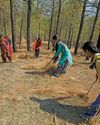
NIRMALA MARAWI choked up with joy and gratitude as she harvested kutki, a little millet, from her 2.8 hectare (ha) field this November. "This is the first crop I have sown on the land in more than two decades," recalls the 55-year-old resident of Manikpur Raiyat village in the tribal district of Mandla, Madhya Pradesh. The land was taken over by lantana (Lantana camara), one of the 10 worst invasive species in the world, and was lying fallow all these years. "I could not even access the five mahua trees (Madhuca longifolia) on my field until we started clearing the weed three years ago," she says. With lantana rooted out, Marawi could collect 250 kg of mahua flowers this summer, which she sold for ₹8,750 in the local market. "So far, I had to make my ends meet with the 0.8 ha farm that remains unspoiled by the weed. My income will now treble with earnings from the reclaimed land," Marawi says. She has, however, not let down her guard and promptly uproots any sapling of lantana that she spots on her field or in nearby areas.
Lantana is not native to India. It was introduced in the country as an ornamental plant by the British in the 1800s, and has since spread over 574,186 sq km, covering 50 per cent of the country's "natural areas", according to an October 2023 study in the Journal of Applied Ecology. A 2020 estimate by researchers, published in the journal Global Ecology and Conservation, shows that the plant occupies 40 per cent of forests (over 154,800 sq km), including tiger reserves. A 2019 review paper published in Botanical Review states that lantana has also invaded most pasture lands (132,000 sq km) in the country. Eradicating lantana is difficult "because of its rapid spread, intensity of infestation, allelopathy [chemicals released to discourage growth of native plants], opportunistic growth behaviour, reproductivity biology traits, and tenacious resistance to cutting and burning," states the review paper.
Esta historia es de la edición December 16, 2023 de Down To Earth.
Comience su prueba gratuita de Magzter GOLD de 7 días para acceder a miles de historias premium seleccionadas y a más de 9,000 revistas y periódicos.
Ya eres suscriptor ? Conectar
Esta historia es de la edición December 16, 2023 de Down To Earth.
Comience su prueba gratuita de Magzter GOLD de 7 días para acceder a miles de historias premium seleccionadas y a más de 9,000 revistas y periódicos.
Ya eres suscriptor? Conectar

THE CIRCULARITY ARGUMENT
A circular economy can help India achieve its developmental aspirations while following the low-carbon pathway. It will also help address the challenges of waste management, pollution and overexploitation of natural resources. Industries are already innovating to reuse high-volume wastes and have shown that the transition can usher in both environmental and financial windfalls

Banking on flawed drug voluntary licences
The Medicines Patent Pool is pushing for more VLs, but its bad deal with Novartis on a cancer drug shows the pitfalls

Lasting solutions
For the first time, the UN has recognised the role of indigenous communities in tackling aridity. A repository of traditional knowledge India has the wherewithal to lead the way

IMD at 150
India's journey into modern weather forecasting took a decisive turn 150 years ago with the establishment of India Meteorological Department during the British rule. The agency has come a long way since then, shaping the way the country predicts and responds to its diverse climate challenges

Every drop counts
In drought-prone Marathwada region, 14 villages have managed to counter water shortage by budgeting the resource

Threat to survival
Hollongapar Gibbon Sanctuary in Assam faces ecological challenges as railway electrification and hydrocarbon exploration endanger its fragile biodiversity

'Migration is going to be a battlefield'
AMITAV GHOSH is one of the foremost chroniclers of our times. His literary sojourn includes writings on topics that range from languages to climate change to human lives. His latest book, Wild Fictions, brings some of his works on these issues under one title. In a conversation with RAJAT GHAI, Ghosh shares his views on the future of human movement. Excerpts:

Face of future
California wildfires confirm forest fires are intensifying in a hotter world, emitting substantial amounts of greenhouse gases and reinforcing global warming

Friends of the forest
Residents of 30 villages in Uttarakhand establish a model for public participation in saving forests from wildfires

Climate-crazy playbook
Just hours after his second (and final) term began on January 20, US President Donald Trump unleashed 46 presidential actions. Several of these are centred on the US' climate commitments, energy transition, migration and trade policies, and are likely to have negative global implications